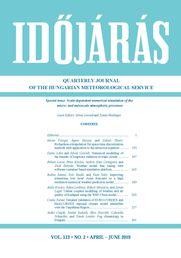IDŐJÁRÁS - angol nyelvű folyóirat
Vol. 123, No. 2 * Pages 135–264 * April - June 2019
 |
Special issue: Scale-dependent numerical simulation of the micro- and mesoscale atmospheric processes |
 letöltés [pdf: 8407 KB]
letöltés [pdf: 8407 KB]
Fog climatology in Hungary
Anikó Cséplő, Noémi Sarkadi, Ákos Horváth, Gabriella Schmeller, and Tünde Lemler
DOI:10.28974/idojaras.2019.2.7 (p. 241–)
Anikó Cséplő, Noémi Sarkadi, Ákos Horváth, Gabriella Schmeller, and Tünde Lemler
DOI:10.28974/idojaras.2019.2.7 (p. 241–)
IDŐJÁRÁS folyóirat

Az IDŐJÁRÁS a HungaroMet Nonprofit Zrt. negyedévenként megjelenő angol nyelvű folyóirata
Megrendelhető a journal.idojaras@met.hu címen.
A szerzőknek szánt útmutató itt olvasható.
Megrendelhető a journal.idojaras@met.hu címen.
A szerzőknek szánt útmutató itt olvasható.









